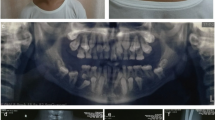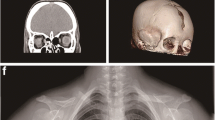Abstract
Cleidocranial dysplasia (CCD; OMIM: 119600) is a rare autosomal dominant skeletal dysplasia caused by RUNX2 gene mutations. The present study described a sporadic case with CCD. The clinical data of the proband with CCD was reported and genetic analysis was performed. The proband presented with typical CCD features including supernumerary impacted teeth, bilateral clavicle dysplasia, delayed closure of cranial sutures, and short stature; while his hands were normal. Sequencing analysis of the entire coding region of the RUNX2 gene revealed no pathogenic changes; however, copy-number analysis with the Affymetrix HD array found \(\sim \)500 kb genomic microdeletion. Real-time quantitative PCR validated this microdeletion in the 1–4 exons of the RUNX2 gene. The junction point of the breaking DNA was located in the directly oriented AluSz6 and AluSx repetitive elements, indicating that this microdeletion might be generated through an Alu–Alu mediated mechanism. In addition, this microdeletion existed in 21.8% of the asymptomatic mother’s peripheral blood cells, demonstrating that the mosaicism was not associated with CCD phenotypes. In summary, a pathogenic microdeletion in the RUNX2 gene located on chromosome 6 was responsible for CCD.



Similar content being viewed by others
References
Campbell I. M., Yuan B., Robberecht C., Pfundt R., Szafranski P., McEntagart M. E. et al. 2014 Parental somatic mosaicism is underrecognized and influences recurrence risk of genomic disorders. Am. J. Hum. Genet. 95, 173–182.
Ducy P., Zhang R., Geoffroy V., Ridall A. L. and Karsenty G. 1997 Osf2/Cbfa1: a transcriptional activator of osteoblast differentiation. Cell 89, 747–754.
Feldman G. J., Robin N. H., Brueton L. A., Robertson E., Thompson E. M., Siegel-Bartelt J. et al. 1995 A gene for cleidocranial dysplasia maps to the short arm of chromosome 6. Am. J. Hum. Genet. 56, 938–943.
Greives M. R., Odessey E. A., Waggoner D. J., Shenaq D. S., Aradhya S., Mitchell A. et al. 2013 RUNX2 quadruplication: additional evidence toward a new form of syndromic craniosynostosis. J. Craniofac. Surg. 24, 126–129.
Gu S., Yuan B., Campbell I. M., Beck C. R., Carvalho C. M., Nagamani S. C. et al. 2015 Alu-mediated diverse and complex pathogenic copy-number variants within human chromosome 17 at p13.3. Hum. Mol. Genet. 24, 4061–4077.
Hansen L., Riis A. K., Silahtaroglu A., Hove H., Lauridsen E., Eiberg H. et al. 2011 RUNX2 analysis of Danish cleidocranial dysplasia families. Clin. Genet. 79, 254–263.
Levanon D., Negreanu V., Bernstein Y., Bar-Am I., Avivi L. and Groner Y. 1994 AML1, AML2, and AML3, the human members of the runt domain gene-family: cDNA structure, expression, and chromosomal localization. Genomics 23, 425–432.
Lou Y., Javed A., Hussain S., Colby J., Frederick D., Pratap J. et al. 2009 A Runx2 threshold for the cleidocranial dysplasia phenotype. Hum. Mol. Genet. 18, 556–568.
McNamara C. M., O’Riordan B. C., Blake M. and Sandy J. R. 1999 Cleidocranial dysplasia: radiological appearances on dental panoramic radiography. Dentomaxillofac. Radiol. 28, 89–97.
Mefford H. C., Shafer N., Antonacci F., Tsai J. M., Park S. S., Hing A. V. et al. 2010 Copy number variation analysis in single-suture craniosynostosis: multiple rare variants including RUNX2 duplication in two cousins with metopic craniosynostosis. Am. J. Med. Genet. A 152a, 2203–2210.
Meyers S., Downing J. R. and Hiebert S. W. 1993 Identification of AML-1 and the (8;21) translocation protein (AML-1/ETO) as sequence-specific DNA-binding proteins: the runt homology domain is required for DNA binding and protein-protein interactions. Mol. Cell. Biol. 13, 6336–6345.
Molin A., Lopez-Cazaux S., Pichon O., Vincent M., Isidor B. and Le Caignec C. 2015 Patients with isolated oligo/hypodontia caused by RUNX2 duplication. Am. J. Med. Genet. A. 167, 1386–1390.
Mundlos S. 1999 Cleidocranial dysplasia: clinical and molecular genetics. J. Med. Genet. 36, 177–182.
Mundlos S., Mulliken J. B., Abramson D. L., Warman M. L., Knoll J. H. and Olsen B. R. 1995 Genetic mapping of cleidocranial dysplasia and evidence of a microdeletion in one family. Hum. Mol. Genet. 4, 71–75.
Mundlos S., Otto F., Mundlos C., Mulliken J. B., Aylsworth A. S., Albright S. et al. 1997 Mutations involving the transcription factor CBFA1 cause cleidocranial dysplasia. Cell 89, 773–779.
Ott C. E., Leschik G., Trotier F., Brueton L., Brunner H. G., Brussel W. et al. 2010 Deletions of the RUNX2 gene are present in about 10% of individuals with cleidocranial dysplasia. Hum. Mutat. 31, E1587–E1593.
Otto F., Kanegane H. and Mundlos S. 2002 Mutations in the RUNX2 gene in patients with cleidocranial dysplasia. Hum. Mutat. 19, 209–216.
Otto F., Thornell A. P., Crompton T., Denzel A., Gilmour K. C., Rosewell I. R. et al. 1997 Cbfa1, a candidate gene for cleidocranial dysplasia syndrome, is essential for osteoblast differentiation and bone development. Cell 89, 765–771.
Ryoo H. M., Kang H. Y., Lee S. K., Lee K. E. and Kim J. W. 2010 RUNX2 mutations in cleidocranial dysplasia patients. Oral. Dis. 16, 55–60.
Singh A., Goswami M., Pradhan G., Han M. S., Choi J. Y. and Kapoor S. 2015 Cleidocranial dysplasia with normal clavicles: A report of a novel genotype and a review of seven previous cases. Mol. Syndromol. 6, 83–86.
Sun M., Ma F., Zeng X., Liu Q., Zhao X. L., Wu F. X. et al. 2008 Triphalangeal thumb-polysyndactyly syndrome and syndactyly type IV are caused by genomic duplications involving the long range, limb-specific SHH enhancer. J. Med. Genet. 45, 589–595.
Thirunavukkarasu K., Mahajan M., McLarren K. W., Stifani S. and Karsenty G. 1998 Two domains unique to osteoblast-specific transcription factor Osf2/Cbfa1 contribute to its transactivation function and its inability to heterodimerize with Cbfbeta. Mol. Cell. Biol. 18, 4197–4208.
Yoshida T., Kanegane H., Osato M., Yanagida M., Miyawaki T., Ito Y. et al. 2003 Functional analysis of RUNX2 mutations in cleidocranial dysplasia: novel insights into genotype-phenotype correlations. Blood. Cells. Mol. Dis. 30, 184–193.
Acknowledgements
This work was supported by National Natural Science Foundation of China (81570960), Ministry of Science and Technology of China (2013CB945400), Suzhou Health and Family Planning Commission (SYSD2015093), Advance Research Programme of the Second Affiliated Hospital of Soochow University (SDFEYBS1603), and the Preponderant Clinic Discipline Group Project Funding of the Second Affiliated Hospital of Soochow University (XKQ2015010). We thank Dr Xiao-zhi Wang from Gminix (Shanghai, China) for assistance with bioinformatic analyses.
Author information
Authors and Affiliations
Corresponding authors
Additional information
Corresponding editor: Rajiva Raman
Electronic supplementary material
Below is the link to the electronic supplementary material.
Rights and permissions
About this article
Cite this article
Qian, Y., Zhang, Y., Wei, B. et al. A novel Alu-mediated microdeletion in the RUNX2 gene in a Chinese patient with cleidocranial dysplasia. J Genet 97, 137–143 (2018). https://doi.org/10.1007/s12041-018-0891-2
Received:
Revised:
Accepted:
Published:
Issue Date:
DOI: https://doi.org/10.1007/s12041-018-0891-2




